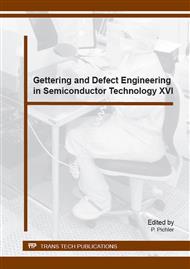p.169
p.175
p.184
p.190
p.196
p.205
p.211
p.218
p.224
Kinetic Model of Precipitate Growth during Phase Separation in Metastable Binary Solid Solutions
Abstract:
In this paper, the kinetics of precipitate growth in metastable binary solid solutions is analyzed considering two mechanisms: (i) diffusion of the one component from the bulk of composition matrix and its incorporation in the precipitate, and (ii) emission and outdiffusion of the second component from the interface of precipitate with surrounding matrix. A kinetic model is proposed that enables a description of these both mechanisms in a unique way. Using this model, the mechanism of oxygen emission and outdiffusion from the interface of Si precipitates with the silicon oxide surrounding is confirmed to determine the phase separation kinetics upon high temperature annealing nonstoichiometric silicon oxide films.
Info:
Periodical:
Pages:
196-202
Citation:
Online since:
October 2015
Authors:
Price:
Сopyright:
© 2016 Trans Tech Publications Ltd. All Rights Reserved
Share:
Citation:


